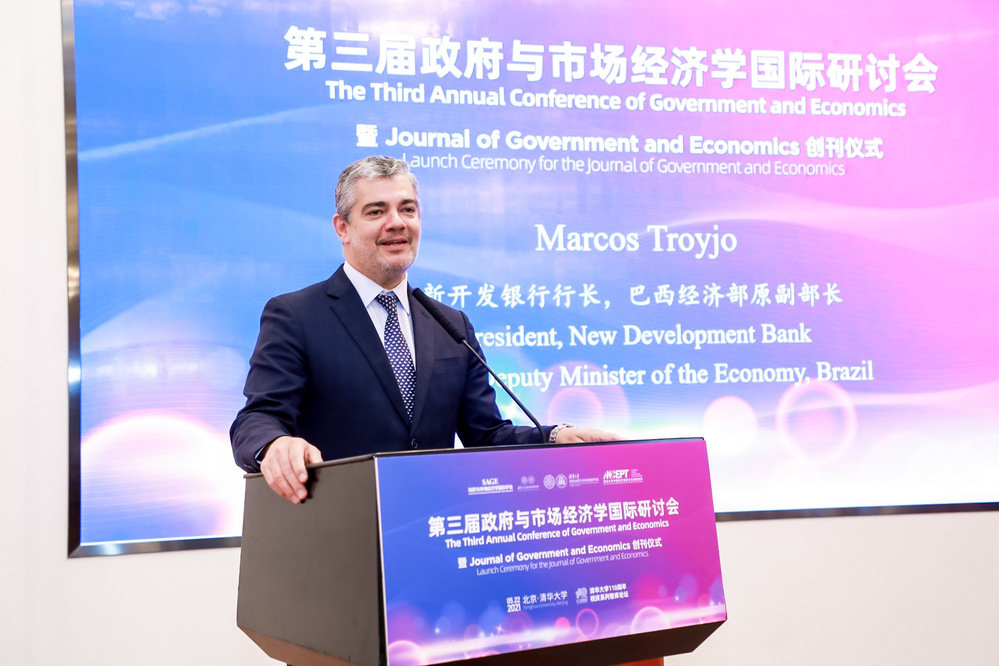Marcos Troyjo: How Should Government and Economics Respond to the Changing Contours of Globalization?
At the Third Annual Conference of Government and Economics, held on May 22, 2021 at Tsinghua University, New Development Bank President Marcos Troyjo reflected on the role of globalization in setting the stage for the relationship between government and economy. The following is a transcript of his lecture that has been lightly edited for clarity.

Good morning! I want to say hello to everyone and to the academic leaders of Tsinghua University, and say how happy I am to be here.
Let me make my first suggestion to you. Maybe you would like to divide SAGE into two departments—department one, which is the Society for the Analysis of Good Government and Economics, and then department two, which is the Society for the Analysis of Bad Government and Economics. Because it seems to me that the way governments perform in the economy is not something that happens in the void. It’s not something that happens only within laboratory conditions; it actually plays out in the real world.
There might be actions that are taken by government that are virtuous—let me give you a few examples. Every single economic miracle since the end of World War II has been powered by a virtuous combination between government and the economic sphere. This has been the case of Germany post World War II. It's been the case of Japan, it's been the case of Spain since the Moncloa Pact in 1982, it's been the case of Singapore, it's been the case of South Korea, it's been the case of Chile, in a certain aspect, in Latin America, and it's definitely been the case of China since the end of the 1970s. In all of these cases, government and the economy were combined in a virtuous manner to produce development. But that is not enough.
I'm Brazilian, but both my grandparents came from Spain, and there was a great Spanish philosopher called José Ortega y Gasset. He used to say, “we are we in our circumstances, we are we in our context.” And why do I tell you that? Because it seems to me that this interaction between government intervention and the economy takes place within a certain framework, and one of the names for this framework is “globalization.” Government and the economy are like actors on a stage, and the name of that stage is “globalization.” The thing is, globalization is something that changes over time. It's like an organism—for a while its chief characteristics remain the same, but then they evolve. Over the period of a quarter-century, the chief characteristics of globalization remain the same, but then they evolve. It is the way that you combine government action and the economy to take advantage of the opportunities of that particular configuration of globalization that will ultimately make or break the success.
For example, one of the questions that has been asked since the founding of economics as a discipline is about The Wealth of Nations. Recently, there was a book by a Turkish economist of MIT called Why Nations Fail—the opposite concept. There's this question that's in our hearts, particularly those who care about development, which is “Why is it that nations rise? What are the propelling engines that make nations rise, that make incomes go up, that make nations more prosperous?” My general answer to this question, which has a lot to do with the interaction between the government and the economy, is that nations rise when they successfully adapt to the changing contours of globalization. So it's a matter of adaptation—because the conditions of globalization change, then the strategy for managing the interactions between the government and the economy must also change accordingly.
Without going too far back into history, let us suppose, for example, that the 100 people we have in this room board a time machine and fly back to the year 1992—almost 30 years ago. If we observed the chief characteristics of globalization back then, we would see that the Soviet Union was no longer a player after the end of the Cold War. That was followed by the emergence of a number of characteristics that many scholars took as eternal truths: the rise of market economies, the rise of liberal democracies, the rise of Western-style rule of law—something that one would probably describe as “the triumph of the West.” These were the reference points used to guide the reorganization of societies and governments.
Thirty years ago, when it came to how nations were negotiating trade, there was a trend toward regional economic integration due to economies of scale, for the sake of efficiency. But the fact is that regional economic integration went beyond mere economics, especially if you judge by the Maastricht Treaty and what happened to the European Union. It started out as something only related to the economic sphere, but then, all of the sudden, there was a common court in Strasbourg, there was a common Parliament in Brussels, there was a Common Agricultural Policy. So, it seemed that the world was moving toward more of a regional world rather than a nation-state-based system, as some governments were beginning to promote regional integration that went beyond economics. This trend was visible in Europe, of course, but also in North America, with the North American Free Trade Agreement including Mexico, the United States, and Canada. You could see that in South America, with Brazil, Argentina, Paraguay, and Uruguay. You could see that in the acceleration of ASEAN here in Asia. In all of these cases, we could see the government and the economy coming together to promote regional integration.
The third element of this globalization of 30 years ago was that the government and the economy were coming together to allow for big tech-intensive corporations to reinvent themselves. There are so many examples of this—every example of industrial policy married with defense policy in the United States, for example, points in that direction. Look at the case of a company like IBM. IBM originally stood for International Business Machines, because this was a company that made physical things like mainframe computers—computers that were as big as this auditorium, and that needed refrigerating systems as big as the computers themselves. Then, all of the sudden, this firm moved away from what is tangible—hardware—into the realm of software, which is the embryo of information systems and big data. So once again, we see that technology is the result of government and the economy providing a context in which innovation could take place. This kind of globalization that I'm describing, chronologically speaking, went all the way from 1992 to 2007, ending in the wake of the Great Recession and the fall of Lehman Brothers. We could even go a bit farther back in history, starting from the fall of the Berlin Wall in 1989 until 2007. There were three key ways in which government and economy came together to face what we could call deep globalization, which I have mentioned to you: market economies, liberal democracies, and Western-style rule of law; regional integration; and the reinvention of big tech firms. We can say that these were the cardinal points of deep globalization.
But for the past 13 years, we have no longer been living in that ecosystem. That is no longer the framework within which government and economics interactions take place. We have probably moved from deep globalization to a stage of de-globalization. Here, de-globalization doesn't necessarily mean reverting to a time before globalization—it should be understood, rather, in terms of physics. For example, when a car is decelerating, it doesn't mean that the car has stopped. It just means that the car is no longer progressing at the same rhythm and speed that it was before. So that's where we have been, I think, for the past 13 years—a scenario of de-globalization. So, what have governments and economies been coming together to do for these past 13 years? The reintroduction of protectionism, the reintroduction of economic nationalism, the reintroduction of policies that could be termed “import substitution 2.0,” and perhaps the reversal of regional economic and political processes. I think some of the most eloquent examples that we've seen of this took place back in 2016, with the decision by the British to leave the European Union and the decision by former President Trump to restructure the North American Free Trade Agreement, now called the US-Mexico-Canada Agreement. So globalization has changed, and we are now in a situation in which we have to approach how government and the economy come together within this framework of de-globalization.
The question here is, since we take a forward-looking approach, and obviously we have to think about what the future is going to be like: “Is de-globalization the modus operandi of how government and the economy will interact for the next 25 years?” My impression is that it is not.
There's going to be a next chapter in globalization, so the way we think about government and the economy in this next phase of globalization will be somewhat different than what we have experienced for the past 13 years. I don't know exactly how it's going to be, but there are at least, I think, four features that will be with us as we continue to think about these interactions that constitute the core of SAGE.
The first feature that we must acknowledge is that there has been a tectonic shift between the emerging and the developed world. In 2019, the combined GDP measured in PPP (purchase power parity) terms of the so-called G7—the traditionally advanced industrial economies of the United States, Japan, Germany, France, the UK, Canada, and Italy—was $40 trillion. Whereas if you look at the E7—China, India, Indonesia, Russia, Brazil, Mexico, and Turkey—they had a combined GDP of $53 trillion, measured in purchasing power parity terms. So today, the E7 is already much more of an important determining factor in the global economy than the G7. Even if you only consider the BRICS (and of course, China has a very big relative size here), BRICS are already bigger than the G7 when it comes to GDP measured in purchase power parity terms. So, it's impossible to think of government action in the economy without realizing that some of the actions that were performed and led by governments in the emerging world have actually produced better results than those in the advanced economies. Many of the recipes that have been provided by the traditional advanced economies and institutions must be taken with a grain of salt. Many of the formulas that were devised back then were not as beneficial to emerging economies as the formulas that those countries came up with for themselves.
The second characteristic in this next chapter of globalization that will have a major impact on the interactions between government and the economy, I think, is the reconfiguration of global value chains. However, I think it's somewhat of a mistake, as do many economists in the world today, to say that this is going to be the result of geopolitics. It's going to be impacted by geopolitics, but that is going to be a minor factor when compared to other influences on the redrafting of global value chains. What are these influences? One is the very natural individual evolution of some of the world's most important economies, particularly those that have held significant manufacturing hubs for the past 30 years. This is the case of China, for example. China is no longer a low-cost country. China is a tech-intensive economy and is making a lot of headway in marketing, service, and development—leading the world in some of the most important technologies. So it's only natural for some manufacturing to migrate away from China, as we have seen in other examples in history. For example, as Japan added more and more value to its production, some of its more labor-intensive activities migrated to other countries in the vicinity, such as Malaysia and South Korea, therefore giving birth to what economic literature later called the Asian Tigers. We are going to see that same phenomenon moving forward as well. It's truly remarkable how countries in China's economic vicinity—like Vietnam, Indonesia, and Myanmar—have increasing abilities to house lower value-added, labor-intensive manufacturing industries. This will be, as I understand it, a very important consideration when it comes to reconfiguring value chains.
In the same way that the evolution of individual economies will play a role, another very important factor will be international trade and investment agreements. Although over these past four years, there has been a lot of talk about the rebirth of the power of tariffs and the power of quotas, the single most significant influence upon how this will impact global value chains is actually to be found in standards—standards of environmental protection, intellectual property rights, how government procurement takes place, etc. As governments devise their strategy for the future, this is something they will have to consider—it is a world of standards. You might say that this is going to create a lot of problems for international trade, so instead of re-globalization, we're going to have de-globalization 2.0 because there's going to be more protectionism. But even in this very tough context, China has managed to put together an investment agreement with the European Union, and so has MERCOSUR. So although there are difficulties, this value chain reconfiguration will take place because of governmental action.
The third element, and perhaps one of the most important, is that as economies have observed cycles such as the gold cycle, the silicon cycle, or the semiconductor cycle, there's something new emerging as the single most important factor of production for this next 25-30 years, and that's talent. Talent, not necessarily as a concept synonymous with personal vocation, but as the capacity to be multi-faceted. Talent as a company, to go beyond your niche market and core business to begin playing different roles. You have many examples of such companies here in China, and there are also the traditional chaebols in South Korea. Talent also means that a country has the diversity and complexity to do many things at the same time, whether that be traditional agriculture, services, or emerging Fourth Industrial Revolution sectors, like biotech and big data. Complexity is the same as talent when it comes to nations, and it is impossible to think of this acquisition of talent for the profile of a nation without a virtuous performance by government, especially as a strategist.
And then to conclude, I shouldn’t leave without saying something about multilateral development banks, especially because now I'm working for one. Multilateral development banks will also have a significant part to perform in this conjunction between government and economics, and in this next phase of globalization. This role is of a threefold manner.
The first is something that SAGE can devote a lot of attention to, which is something that I call the metamorphosis of infrastructure. So traditionally, we have thought about physical infrastructure, social infrastructure, national health, and soft infrastructure like technology—everything is blended together. It's impossible, for example, to think of infrastructure in terms of building a school premises without having that connected to the internet and the devices that will allow for some sort of distance learning for students who are unable to attend in person. The other day, I was speaking to a very important social scientist at Stanford University. I asked him what he thought was the most important infrastructure challenge in the world today, and he said it's probably the fact that because of COVID, half a billion children in the world today are not able to take in-person classes. And many of these children, because they lack the basic elements of connectivity, cannot afford to have distance learning. That is infrastructure in the 21st century, and governments have a role to play in that.
The second characteristic of MDBs is recombination. There is a Russian-American social scientist called Pitirim Sorokin, and he said that at times, social evolution happens because of a process of saturation. Saturation is when you have molecules together, but then because of fatigue, they break apart, and later are combined in a new way. The same thing is happening to development policies. In our traditional models of development policy—export-oriented, state-led, private-sector-led, market-oriented—everything is going to have to be recombined. And the way this will happen will very much be the result of the kind of questions we ask. So SAGE has to ask the right questions in terms of what new development policy is going to look like.
Thirdly, and finally, I think multilateral development banks will also have a very beneficial role to play in this next chapter of globalization if they become hubs of international cooperation. This is something that governments must understand as well. In the world today, on the 22nd of May 2021, there is a major deficit of international cooperation because of a lack of trust and geopolitical rivalries. We cannot allow that to happen, and if we can bridge that cooperation gap, then we will actually be responding favorably to something that Professor Maskin has raised, which is avoiding sub-optimal results. So I look forward to interacting a lot with your society, and I look forward to having the NDB play a positive role in your deliberations on how best to combine government and the economy.
Thank you very much.




